#eroica symphony
Text
Comparing the intros to Eroica vs Wellingtons Sieg by Beethoven *fanboy screaming*
Inspired by @impetuous-impulse 's long-post essay on if Wellingtons Sieg was a certified banger or just liked because of its political ties. Very interesting, go read the post. Also literally don't worry about being socially awkward while interacting with me, my tumblr tag is literally diagnosed anxiety disorder, I understand if you get social anxiety in my notifs 😭
I'm going to put the post under a Keep reading so my mutuals don't get sieged with a wall of text on their dash ahaha
tldr: Wellingtons Sieg focuses more on imagery and takes a more cinematic/patriotic approach, sacrificing a bit of melodicism. While Eroica is very lyrical and musical, having a steady motif that it grows on, but I wouldn't know that it's about war if someone didn't tell me. Both pieces focus on different aspects of musicality and in their own domain, they perform quite well. I like Eroica more since it's more musical in my opinion, but Wellingtons Sieg is also really dramatic and cool. This is just my personal taste. I recommend listening to both and formulating your own opinion! Both pieces really do sound very Beethoven-esque though
ok coming at this from a musician's perspective and not a historical perspective (since there's plenty of you history buffs out there haha). I had to play a bit of Eroica for an orchestra audition and I just took the time to listening to a bit of Wellington's Victory and sight read the conductor's sheet music. I will now proceed to do a long post looking at the intros of Eroica and Wellingtons Sieg because I don't have the time to listen to both of them in their entirety right now
Just going to put it out there, Eroica and Wellingtons Sieg are both in Eb Major, which is practically known as the heroic key, but that's probably because of Beethoven. The only difference is that Wellingtons Sieg first starts in Eb, then goes to C major (bright and festive) then goes to B major (in this use it's similar in mood i think to C) and then it goes back to Eb.
First of all, I will tell you right now that I like Eroica more than Wellingtons Sieg. Not only am I biased but I've actually listened to Eroica in its entirety multiple times.
At the start of Wellingtons Sieg (after the dramatic snare drum and trumpet fanfare thingies) you have this nice cute little motif. The motif actually ends after the down beat in measure 8 but I wanted to include the crescendo poco a poco. Anyways, this is in Eb and it's backed up by a bunch of quarter note Eb's on the down beats as well. It's a simple melody and it kinda feels like a marching song honestly. During the whole crescendo part it kinda does a whole developmental twisty thingy with the motif and then lands on a forte and it ties it all together at the end with a small recapitulation of said motif. This whole intro just feels like the army marching into battle and whatnot.

Eb Major motif ^^^ I really like it! The staccatos and major key makes it feel very bouncy and lively
Then Beethoven decided that the army is not done marching actually and he's actually going to change the time signature entirely, giving the next upcoming C Major section an entirely different feel. In fact, an entirely different melodic motif, because it makes it ✨interesting✨. So after an even longer period of the snare drum going insane in a triplet-based time signature and then the trumpets follow up with their loud repeated notes since trumpets are good at doing that, then we have another motif!

C Major motif ^^^ (pretend like there's a quarter note C in the invisible measure 8, it was written on a different page so i had to cut off the resolution im sowwy) .
Similar to the first motif, it also has a light and bouncy feel with all the staccatos. The grace notes play a similar role as the 16th notes in the Eb motif as well. I mean, C is the 6th of the Eb major key, but I don't know enough music theory to know the significance of that :/ (im taking AP music theory next year though!!!). So this motif repeats itself a bunch of times in different modulations in 3rds (i think) while the violins either do nothing or echo the melody. Very big focus on the band, especially brass probably.
And then... we get into the part that is probably when the army actually reaches the battlefield. Now, we have our two soldiers right, the Eb motif and the C motif. These two soldiers were obviously on the front lines and got brutally one-shot killed by artillery or something because in the B major section there is literally no motif at all!!
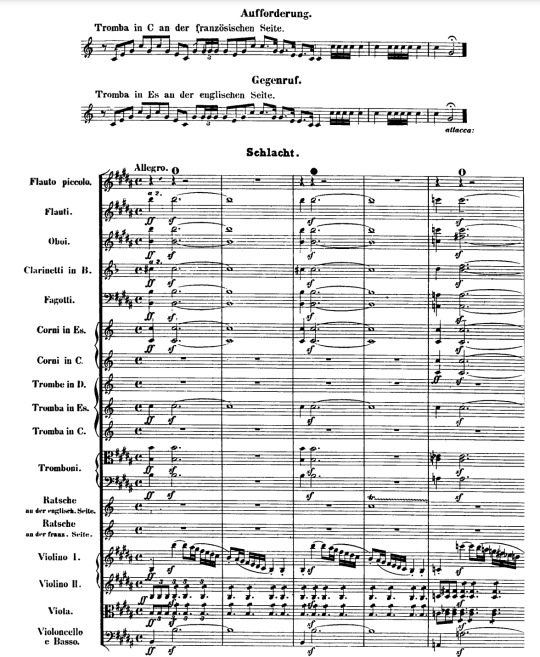
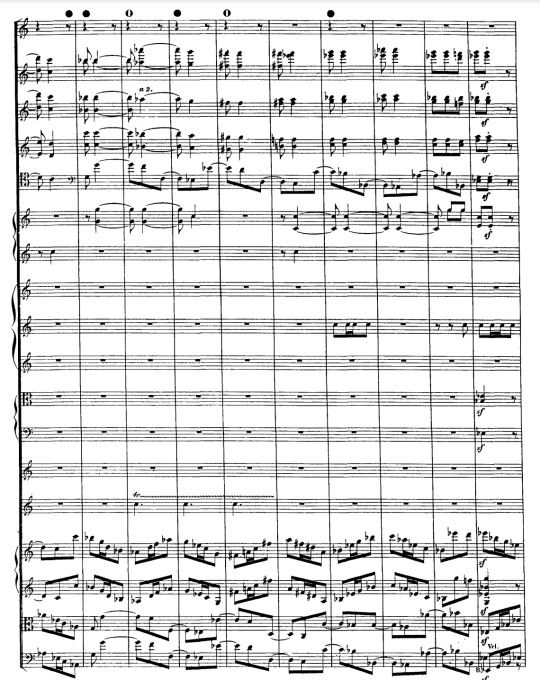
Ok, these two screenshots are 11 pages apart. Beethoven wanted to torture the violinists for a bit. He's literally doing what Wagner did for Ride of the Valkyries where he turns the violins into little Christmas ornaments and gives the brass section a field day. Moments like these are the reason why most of the violinists I know wish they picked the cello instead because wow look at all those juicy quarter notes and long notes ties, very chill. Also the second page that I screenshotted is when the key shifts from B major to Eb major. It's not written in the key signature but the accidentals suggest that the key is different because Beethoven wanted to make sure that no violinist was sight reading on the day of the concert, which is totally something I've never done before (haha... sorry maestro 💀)
I don't think you really need to read sheet music to understand what's going on. The winds are just holding long dramatic notes while the strings are having a stroke. This part of the piece is very cinematic and it very much sounds like the background music for a 1800s based war movie. A lot of times when pieces are based on.. uh... "things" they tend to ditch melodic lines for foley impressionistic sounds. There was this one concert I went to for my city's philharmonic orchestra and they played a piece based on Nazi Germany and they literally used two metronomes that were going off asynchronously as apart of the piece. I mean, the piece was very 1900s modern so... but that's the only example that's at the top of my mind right now.
What I'm trying to say is that there's no melody. Or at least there's no clear lyricism or melodic line that you can pinpoint, or there's no sense of melodicism that I can find with my mediocre knowledge of music theory and composition.
Overall, the intro of Wellingtons Sieg is very cinematic, in its sense that the musical lines paint a picture of the army marching to battle and then roughhousing it on the front lines in the section I just talked about. I really liked the motifs at the beginning, I hope Beethoven recapitulates on them at the end of the piece :(

Alright onto Eroica– I love how it just jumps just straight into the theme after the grandiose entrance. I love the intro to this piece so much, the cellos have such a beautiful rich tone with the arpeggiated Eb 2nd inversion chord while the strings just have a bubbly metronomic portato touch, it's so satisfying. Then when the violin I's take over with the G to Ab dotted quarter notes and how it just leads into the next phrase. Then the end of the first motif is on the same beat as the repeat of said motif but the woodwinds play it instead, contrasting from the deep cello sound to a more free and gentle tone it's really beautiful.
Just listen to the Berlin Philharmoniker play it, they do such a good job with the phrasing and musicality. The Berlin Phil is one of if not the best orchestras out there in my opinion. Each section is so in time with each other it just sounds like a one person powerhouse from each instrument. I wish I can play in an orchestra even a fraction as well-refined as them one day. Nothing wrong with my school's orchestra, it's just aaaa Berlin Phil <333
I don't know where this happens in the sheet music, but after some developmental stuff building off of the Eb major chord motif that is juggled between the sections, the strings lead up to a tremolo-d Eb note and then the brass takes over and plays the Eb chord motif. It's so grandiose and probably sounds amazing live.
The melodic line moved from a soft but rich tone from the cellos to a calm interjection from the violins, sounding like a sigh that is carried on by the woodwinds. The woodwinds take their own artistic spin on the melody as the violins gradually crescendo in anticipation to the climax of the exposition. At the peak of the phrase, the brass section majestically explodes and sound goes everywhere and it's just... Beethoven. The piece feels like a really nice hug
With that being said, I kind of focused on two different things for the two pieces. Wellingtons Sieg tells a story through its music while Eroica is more melody based. Wellingtons Sieg does a great job on portraying a certain patriotic feel through its use of percussion and the brass section. It gets its point across that it is about a heroic war victory, listening to the piece is like watching the battle unfold in front of you. While Eroica, ah Eroica... it's majestic in itself. I don't know how else to describe it other than it really sounds like Beethoven. The way he stamps the epic Eb major motif all over the place and plays with the notes, always making it interesting, it's so nice to listen to.
These two symphonies are both musical in their own way. I believe these two symphonies were written roughly a decade apart, so a lot could've happened to Beethoven personally to influence how he sounds. Wellingtons Sieg definitely has its patriotic zeal thoroughly seasoned across the score while Beethoven's heart bled out on the pages of Eroica.
They're both beautiful in their own special Beethoven-esque way. I'm not historically educated enough to tell you what the audience of the time would prefer but what I think is the most important is to know your own opinion. Like how you don't read a book, the book reads you, music is interpreted differently for every pair of ears, or singular ear (not discriminating van Gogh). Music is for everyone, but at the same time, not for everyone. No matter the political introjections or emotional ties, art will always be art and will be seen differently by any audience. I think it's more important to just experience the music for yourself and figure out what you like.
Alright, this post is long enough. I'm not familiar with making long posts so I have no idea if I did this correctly ._. Thank you for reading this in its entirety if you did, I really appreciate it!
All this talk about Beethoven is making me want to relearn the Beethoven Sonatas I was working on on the piano and violin. Anyways, I gotta study for one of my final exams that is... uh... tomorrow.. and I totally studied for it hahaa.. ha... ... please wish me luck, I need it
ok, I'll shut up now, 再见
The End !
#ludwig van beethoven#classical music#wellington's victory#wellingtons sieg#eroica#eroica symphony#classical music history#music theory#music analysis#long post#ranting#symphony#eroica vs wellingtons sieg
30 notes
·
View notes
Text
youtube
#beethoven#michael jayston#biography#Biography 1970#rare#ludwig van beethoven#great composer#napoleon#eroica symphony#haydn#edward hardwicke#judy parfitt#piano#genius#great music#classical#hard to find#Michael Jayston as Beethoven#deaf#tragic#drama#dramatic#youtube#deafness#talent#napoleon I#emperor napoleon#Youtube
2 notes
·
View notes
Text
youtube
57 different recordings of the opening chords from Beethoven’s 3rd Symphony (“Eroica”), arranged chronologically.
This video is from 2013, but I only learned about it today from the New Yorker story in my previous post. Anyway, I think it’s neat, and you can definitely hear the tuning difference with the historically-informed (a.k.a. period-instrument) orchestras.
0 notes
Text
Now that we know Ford owned Beethoven records, there's a part of me that's imagining Stan on his birthday, getting drunk and skeet-shooting his brother's classical music collection. Every time he picks up a record, he takes a swig of cheap whiskey, reads the title, making certain to insult it before hurling the thing into the sky and blasting it to bits.
"Egmont?" Stan slurs, frowning at the wild-haired, stony countenance glaring at him from the cover. "More like egghead."
With a wild, staggering movement, Stan slings the disc, cover and all, into the starry night. It takes him a few tries, the pop-pop of gunfire piercing the veiled, shadowy horizon of trees teetering dangerously from side to side, like one of those rickety pirate ship rides on the Jersey boardwalk. Stan takes another large swig from the bottle, some cheap shit he liberated from behind the bar of the only watering hole in Gravity Falls, wiping his mouth with the back of his sleeve as the shotgun in his other hand weaves a shaky figure eight before finding its mark with the satisfying crunch of vinyl.
"FORE!" Stan yells, flinging his arms out to the side with a maniacal cackle. The exaggerated movement overbalances him, Stan wavering on his toes for a suspended moment before crashing to the ground, shotgun and bottle still firm in his grasp, any pain from the sudden impact buried under thick, gauzy layers of fourth-rate booze.
"Ugh, that's gonna leave - it's gonna - " Reality spins on a crooked axis as Stan claws his way to his hands and knees, dirt settling into small crevices under his fingernails, khaki paints splotched in various shades of earth.
Stan lets his head droop, the accumulation of a miserable, muggy summer's eve coalescing like tributaries on tip of his nose, sweat dripping from his face in large globules onto the pile of remaining records. The young, dark-haired Beethoven staring back at him almost looks like he's crying.
"Stupid nerd. Stupid poofy nerd hair. Stupid nerd frown. I bet you wore glasses, too, you arrogant son of a bitch."
The lettering at the top of the record cover is worn, Stan squinting at the dated font superimposed over a dark triangle-shaped hat adorned with three tall feathers.
"Erotica Symphony," Stan incorrectly reads, picking up the record as he struggles to his feet. "That's some real fucking culture, Sixer."
The man on the cover is long dead, his story kept on life support by a small cottage industry of nerds and wealthy elite. This man with the curly brown hair and dour expression who was supposedly a genius but was now nothing more than a distant memory copied onto aging skin and a coded message etched into vinyl grooves.
Twenty-nine years.
Stan gulps down the last of the whiskey with a vicious swallow, hurling the empty bottle towards the Shack where it shatters into a thousand jagged pieces. He stares at scene, effect taking the circuitous route to catch up with cause, Stan swearing under his breath as he realizes he's going to have clean that shit up tomorrow.
"What do you think, Beethoven?" Stan asks the record, exhaustion rushing into the space adrenaline left vacant. "Is it even worth having a tomorrow?"
No answer is forthcoming. Stan takes a few minutes to reload his shotgun, Beethoven's surly countenance his only unwilling conversation partner, the record perched against a tree trunk as if it were a child's doll or a puppet.
"No opinion, then. You just don't care, do you?" Stan swallows over the hard lump in his throat, grip tightening around the shotgun in his hands.
The record has no response.
Stan gives a humorless laugh as he lurches to his feet, taking the record in one hand, holding it up to his face to look it eye-to-eye.
"Well, it's a damn good thing I care enough for the both of us."
With that, Stan launches the record into the air, the summer's midnight symphony a passing, crackling storm of plasticine showers.
#hello there#i was not expecting this to turn into a semi-story#oh well#stanley pines#so...go look up young and old beethoven and you can see why a drunk stan would start talking to him this way#also - it's the eroica symphony and was originally dedicated to napolean#and yes the last sentence is a passing reference to the pastorale#writing#the eternal struggle#now that i know ford was a classical music nerd the IDEAS that i have#ohhhh boi
16 notes
·
View notes
Text
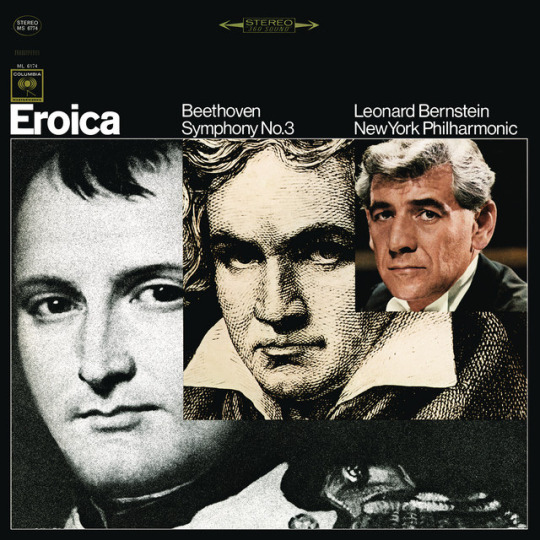
Leonard Bernstein’s face on Beethoven’s face on Napoleon’s face
#Napoleon having the softest face of them all#:)#Napoleon#Beethoven#leonard bernstein#classical music#classical#music#Symphony No. 3 “Eroica”#Symphony No. 3#Eroica#napoleon#napoleonic era#napoleonic#napoleon bonaparte#first french empire#french empire
22 notes
·
View notes
Text



Beethoven's 'Eroica' was on the radio today.
I made these captions based on the Spanish dub.
3 notes
·
View notes
Text
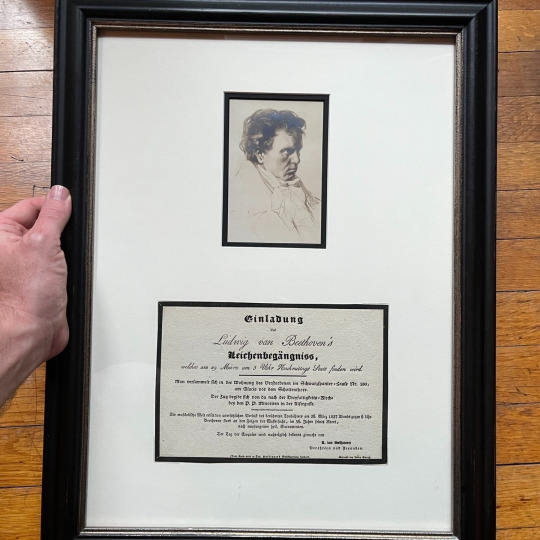
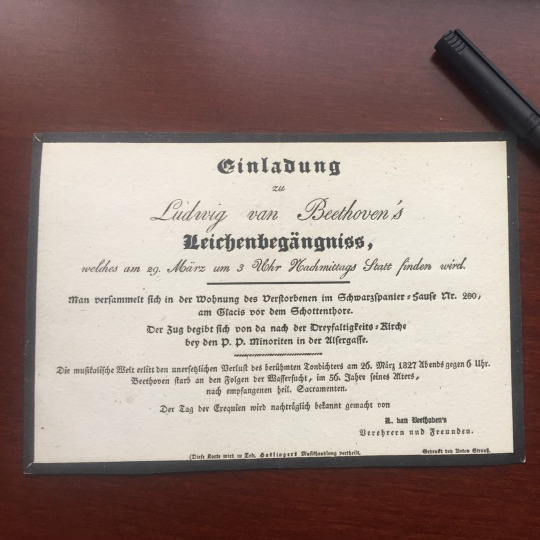
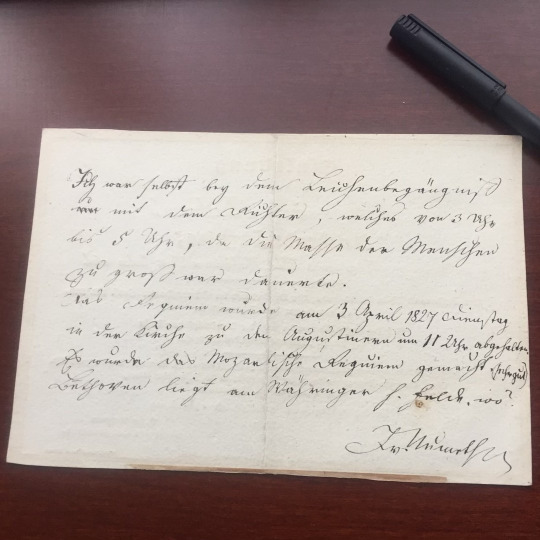

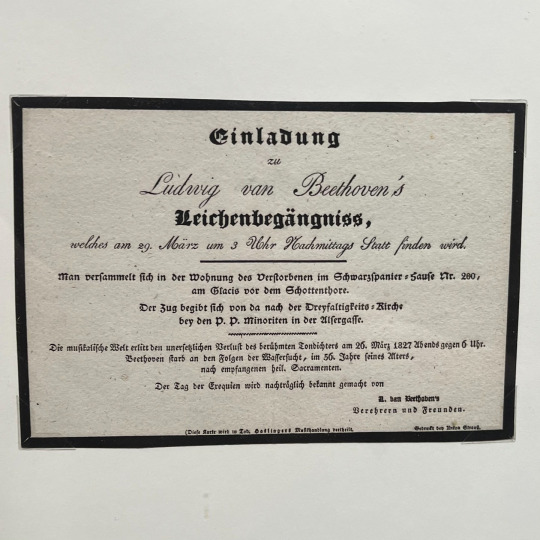
OTD in Music History: Ludwig van Beethoven (1770 - 1827) is laid to rest in Wahring Cemetery in Vienna.
(Beethoven's remains would later be exhumed for scientific study in 1863, and then exhumed a second time and relocated to Vienna's Zentralfriedhof Cementary in 1888. He now lies in a grave adjacent to Franz Schubert's [1797 - 1828] final resting place.)
Beethoven's funeral procession was attended by an estimated 10,000 people -- the largest public mourning turnout in Vienna's history up until that point. Schubert served as one the official torchbearers, and a funeral oration was written and delivered by noted poet Franz Grillparzer (1791 - 1872). Music composed by both Beethoven and his highly-esteemed contemporary, Luigi Cherubini (1760 - 1842), was performed.
Grillparzer's oration can be read here: http://www.lvbeethoven.com/Bio/BiographyFuneralOration.html
PICTURED: An original printed invitation to attend Beethoven's funeral, featuring text that was written by one of Beethoven's closest friends, Stephan von Breuning. It reads:
"Invitation to the funeral
of Ludwig van Beethoven,
which will be held on March 29 at 3 pm.
We will meet at the home of the deceased in Schwarzspanierhaus, 200, on the Glacis,
opposite the Schottentor.
The procession will move from here to the Dreifaltigkeitskirche [Trinity Church]
at the Fr. P. Friars Minorite in the Alsergasse. [via Alser]
The musical world suffered the irreparable loss of the famous composer on March 26, 1827 around 6 pm. Beethoven passed away in his fifty-sixth year of age, from dropsy, after receiving the holy sacraments.
The day of the suffrage mass will be announced later
by the admirers and friends of Ludwig van Beethoven.
(This ticket is distributed in Tobias Haslinger's music store.)
Printed by Anton Strauss."
A mourner who actually witnessed the funeral has handwritten a contemporaneous account of what he saw on the back of this particular copy of the invitation.
#Ludwig van Beethoven#Beethoven#composer#classical composer#pianist#classical pianist#piano#classical music#music history#Symphony#Eroica#Concerto#Cadenza#Chamber music#music#Sonata#Moonlight Sonata#Für Elise#Fidelio#opera#bel canto#aria#diva#maestro#prima donna#chest voice#Cantata#classical musician#classical musicians#classical studies
4 notes
·
View notes
Text

This album cover made me laugh all day
#i know it's a bit impolite but#HAHAHAHAHAHAHAHAHAHAHAHA#napoleon bonaparte#ludwig van beethoven#Eroica#Symphony No.3
2 notes
·
View notes
Text
5 notes
·
View notes
Text
youtube
If you are in Berlin Wednesday, 10 May and would like to see this performed in the Berlin Philharmonie, let me know. My guest list has a bunch of tickets and you only have to pay a service charge of 5 Euro.🎶❤️😁
#beethoven#symphony nr 3#eroica#berlin#berlin philharmonic#practically free shit#Youtube#herbert von karajan
1 note
·
View note
Text
Was in an hour carride with my parents and I was getting sleepy from being car-sick and then my dad just started blasting the Eroica symphony to wake me up 😭😭 I mean it worked but the first two chords scared me so bad
2 notes
·
View notes
Video
youtube
Ludwig van Beethoven, Symphony nº 3 «Eroica», op. 55 (II. Marcia funebre).
Jordi Savall, director
4 notes
·
View notes
Text

José Segrelles - Eroica Symphony, 2nd Movement, The Funeral March by Beethoven (1927)
121 notes
·
View notes
Text
Beethoven wrote his 3rd symphony about Napoleon and in the dedication he wrote: “to celebrate the memory of a great man.” :’)
60 notes
·
View notes
Text
Thank you for the tag, @baronessblixen-- went about this slightly different than the rules-- shuffle on a repeat playlist, post the first 10 tracks, and tag ten people-- because I don't use playlists.
I decided to select an OST, randomly generate a number, and list the corresponding song below:
"Posh!", Chitty Chitty Bang Bang
"Symphony No. 3, Op. 55 (Eroica): I. Allegro con brio", Beethoven
"Chin Up", Charlotte's Web
"Eric to the Rescue", The Little Mermaid
"How Can I Refuse", Barbie The Princess and the Pauper
"Stroll Through the Sky", Howl's Moving Castle
"There's Always Tomorrow for Dreams to Come True", Rudolph the Red Nosed Reindeer
"Climb Ev'ry Mountain", The Sound of Music
"I Dreamed a Dream", Les Miserables
"La Esmeralda", Pugni
Tagging: @welsharcher, @agent-troi, @amplifyme, @suitablyaggrieved, @dd-is-my-guiltypleasure, @cecilysass, @aloysiavirgata, @perpetually-weirdening, @enigmaticdrblockhead, @settle-down-frohike, and I think that's over ten, so I'll stop~.
#tagged#Tumblr#mutuals#whoo this was fun!#trying to keep to the tag rules#but the urge to keep tagging is strong
54 notes
·
View notes
